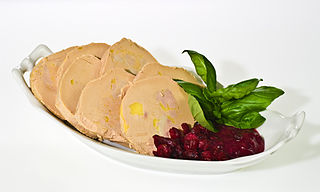A dinner party in France is seen very much as an opportunity for friends and family to spend quality time together and can last many hours and sometimes cover six courses or more.
Christmas or New Year’s Eve dinner is called a “réveillon” after the word réveil (awakening), as in theory it involves staying awake until well after midnight. This tradition can be traced back to the mid-1800s when elaborate dinners were eaten by families when they returned home from Church after the Midnight Mass.
A couple of specialities that you might be served over the festive season.
FOIE GRAS
 Despite the many ethical issues (publishing this article does not reflect the views of the editor) surrounding the force feeding of ducks or geese to enlarge their liver, the resulting foie gras is nevertheless part of the French heritage. A delicacy eaten throughout France on special occasions.
Despite the many ethical issues (publishing this article does not reflect the views of the editor) surrounding the force feeding of ducks or geese to enlarge their liver, the resulting foie gras is nevertheless part of the French heritage. A delicacy eaten throughout France on special occasions.
Foie gras entier (whole foie gras), made of a whole liver, may be either cooked (cuit), semi-cooked (mi-cuit), or fresh (frais). It can be bought from the butchers and is often “pan- fried” in slices and served hot either as a starter or on top of a fillet steak. (Tournedos Rossini)
Bloc de foie gras, cooked and shaped, with a minimum of 90% foie gras.
Should have rich taste and smooth texture. Buy it avec morceaux (with pieces) of foie gras for a rougher texture.
Pâté de foie gras/mousse de foie gras.
Usually a combination of the meat of the bird and a small amount of the foie gras. Check the percentage of Foie Gras on the label.
Duck (Foie Gras de Canard) or Goose (Foie Gras D’Oie)?
Goose foie gras is less common and more expensive than duck foie gras because its production requires more intensive care and feeding. Its taste is more intense than duck foie gras.
TO SERVE
Place it in the fridge for a couple of hours before serving so that it is chilled but not ice cold. Take out of fridge 15 minutes before serving and cut it into 10mm slices. Serve as a starter with toast triangles or crusty farmhouse bread or as a fabulous accompaniment to a sparking glass of champagne to celebrate just about anything!
FAUX GRAS
If the idea of force feeding of ducks and geese takes away your appetite, why not look out for the guilt-free alternative, faux gras, a novel twist on the classic recipe, made from the naturally fattened livers of free range geese and ducks, blended with goose or duck fat to produce a creamy texture similar to traditional foie gras. Cheaper and more humane, as long as you are quite happy to eat the waste organ of a bird in the first place.
MARRONS GLACES (Candied chestnuts)
 First created during the reign of Louis XIV, these candied glazed chestnuts are eaten around Christmas time in France, a fairly costly luxury as true marrons glacés take several days to cook from start to finish. (See recipe below)
First created during the reign of Louis XIV, these candied glazed chestnuts are eaten around Christmas time in France, a fairly costly luxury as true marrons glacés take several days to cook from start to finish. (See recipe below)
First, the chestnuts are washed & sorted, then boiled so that the shell and inner membrane come away easily. They are then cooked repeatedly in a rich vanilla syrup until the flavour seeps into the heart of the chestnut.
To make them, peel around two and a half pounds of chestnuts, and blanch in lightly salted water to loosen membranes.
Peel membranes off the chestnuts, discarding the water, and set them aside. In a heavy saucepan, heat a litre of water along with two heaping cups of sugar and a crushed vanilla bean until all of the sugar has dissolved, and then simmer for five minutes.
Add the chestnuts, bring the mixture to a boil, and cook for 10 minutes. Then cover the saucepan and allow it to sit for 12 hours.
Bring to boiling for one minute, cover and allow to sit for 24 hours, after which heat again, hold at boiling for a minute, cover, and leave for 24 hours again.
Repeat this process until all of the syrup has been absorbed, and then lay the marrons glacés out to dry in a warm oven.
Allow to cool completely.

